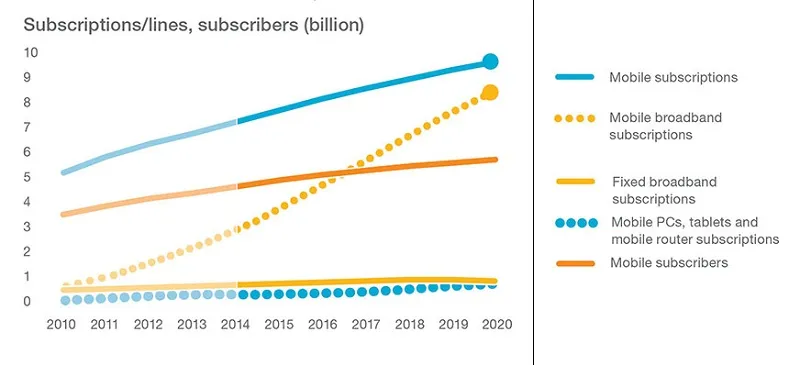90 percent of world's population will have a mobile phone by 2020
The proliferation of mobile technology continues at a rapid pace, as revealed by the latest report on mobility by Ericsson. By the year 2020, 90 % of the world’s population over six years old is predicted to have a mobile phone of which 6.1 billion will have a smartphone subscription.
Fastest growth for new mobile subscriptions was found in India and China, with 18 million and 12 million net additions, respectively, in Q3 2014.

Rima Qureshi, Senior Vice President, Chief Strategy Officer and Head of M&A, Ericsson, says:
The falling cost of handsets, coupled with improved usability and increasing network coverage, are factors that are making mobile technology a global phenomenon that will soon be available to the vast majority of the world’s population, regardless of age or location. The Ericsson Mobility Report shows that in 2020 the world will be connected like never before.
800 million new subscriptions in 2014
Smartphone constituted 65-70 % of all phones sold in the third quarter of 2014, compared with 55 percent in the same quarter for 2013. Despite this increased rate of sales, which will see the addition of an estimated 800 million new smartphone subscriptions by the end of 2014, there seems to be plenty of room for growth in the sector. Smartphones currently account for just 37 percent of all mobile phone subscriptions, which means that many users have yet to make the switch to the more feature-rich, internet-friendly option.

According to the report, the number of smartphone subscriptions will rise from 2.7 billion today to 6.1 billion in 2020.
Domination of video content
Video continues to dominate mobile networks: in 4G-dominatednetworks it currently constitutes 45-55 percent of mobile traffic, driven largely by increased usage of video streaming and improvements in the mobile video experience. Video is increasingly appearing as part of other online applications such as news and adverts, and on social media platforms. At the same time, growth in video streaming is being driven by access to over-the-top (OTT) services and content, such as those provided by YouTube.
Devices used to watch video are also evolving. Many have larger screens, enabling higher picture quality for streamed video, which results in video being consumed on all types of devices and in higher quantities, both at home and on the move. In future, mobile video traffic will increase tenfold by 2020, ultimately constituting around 55 percent of all mobile data traffic in 2020.
Time for 5G !
5G is expected to be commercially deployed in 2020, and the technology is predicted to have a faster uptake than 4G LTE, just as 4G had a faster uptake than 3G. The difference here is that, in addition to new radio technologies, 5G will also encompass evolved versions of existing radioaccess (such as 3G and 4G), cloud, and core technologies to cater for the thousands of new ways that mobile technology will be used. 5G growth will be driven to a large extent by new use cases, especially in machine-type communications.

If you're a mobile startup, or an enthusiast from the mobile world, you should check out the third edition of MobileSparks themed 'Made In India'. For more details, please visit the website.







